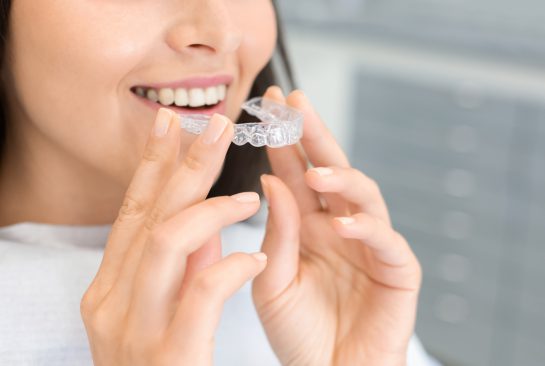- SHOWCASE

Invisalign Dental Braces vs Traditional Braces: Which One is Right for You?
Introduction: Navigating Orthodontic Choices
If you are thinking about straightening your teeth then you will be pleased to know that there are a wide range of orthodontic treatment options to choose from. Modern orthodontics offer many effective alternatives to traditional braces. Although traditional braces remain the gold standard in teeth straightening, Invisalign has become a popular choice of orthodontic treatment for patients across the world. They differ in their approach to teeth straightening and cater to your unique dental needs as well as personal preferences.
To decide whether traditional braces or Invisalign dental braces are most suitable for you, you need to understand the advantages and limitations of each. Your decision will also depend on your lifestyle, budget, and specific dental requirements. In this article we will highlight the essential aspects of both options. This includes cost, treatment duration, comfort, and insurance considerations, so that you can make an informed choice that best suits your individual dental health needs.
Understanding the Basics: Invisalign vs. Traditional Braces
What is Invisalign?
Invisalign Is a modern method of teeth straightening that has quickly become one of the most popular choices amongst patients of all ages across the world. Invisalign works using a sequence of clear, bespoke aligners which work together to move your teeth into a neater formation. These aligners, made from a smooth and virtually invisible plastic, are an ideal option for patients who are looking for a discreet method of teeth straightening.
To begin with you will need to book an appointment with your dentist who will carry out a thorough examination of your teeth and gums. It is important that you have good dental health before you begin orthodontic treatment to prevent any future complications.
Your dentist will assess the degree of misalignment of your teeth and carry out an intraoral scan to create a detailed digital impression of your teeth. They will be able to show you how your teeth will look following successful Invisalign treatment. If you wish to proceed, this blueprint is then used to create a series of Invisalign aligners. The aligners are individually tailored to your dental structure, ensuring a targeted and effective treatment. Each aligner is worn for approximately two weeks before transitioning to the next in the sequence, gently guiding your teeth to their correct alignment.
There are many advantages of Invisalign. To begin with the aligners are clear when worn in the mouth which means that you can straighten your teeth at your discretion. The aligners are removable which means they can be taken out and removed as necessary. You can enjoy all your favourite food and drinks without worrying about damaging your braces. Also it means you can maintain your normal dental hygiene routine with reduced risk of developing cavities or tooth decay.
What are Traditional Braces?
Traditional braces are metal braces which consist of small metal brackets and wires that are attached to the front of your teeth for a certain period of time to achieve a neatly aligned smile. The wires are adjusted or tightened at regular intervals, applying constant pressure to the teeth for straightening and alignment. Traditional braces are the gold standard of orthodontic treatment and can be used to correct a wide range of misalignment issues with long lasting results. They can be used in patients of all ages and are most commonly seen in teenagers.
Despite their more noticeable appearance, Traditional braces are a popular choice especially amongst dentists because of their ability to correct complex orthodontic issues. This may not be possible with alternatives such as Invisalign. For example, traditional braces can be used in the correction of very crooked teeth, overlapping teeth, bite disorders such as overbite and underbite as well as overcrowded teeth. Invisalign is better suited for cosmetic issues although it can be used successfully in mild or moderate orthodontic cases.
Comparative Analysis: Aesthetics, Comfort, and Convenience
Aesthetics
One of the key differences between Invisalign dental braces and traditional braces is the aesthetic appearance of each. Invisalign has been designed to provide a discreet orthodontic treatment with the use of clear, almost invisible aligners. This means it is a highly popular choice of orthodontic treatment amongst adults as well as conscientious teenagers who wish to straighten their teeth without drawing added attention to their mouth.
Traditional braces are attached to the front of the teeth and because of their metal components they are visible when you smile or speak. However with advances in dental technology, traditional braces have become more sleek and discreet than before and you can speak to your dentist about clear components which attract less attention. However, dentists agree that the visibility of traditional braces is considered a small compromise for their effectiveness and dependable outcomes.
Comfort and Oral Hygiene
There is a noticeable difference between the comfort of Invisalign dental braces and traditional braces. invisible line dental braces are created from a smooth up plastic designed to fit snugly over your teeth. They are comfortable to wear and there is minimal risk of developing cuts or sores in the mouth. Traditional braces however are made of metal components which may take a while to become accustomed to. During the initial adjustment period the brackets and wires can rub against the soft tissues of your mouth causing minor cuts or sores however you can speak to your dentist and find out about applying dental wax to the components to minimize irritation.
Another key difference between Invisalign and traditional braces is that Invisalign is removable whereas traditional braces are fixed to your teeth. It is significantly easier to maintain your dental hygiene routine with Invisalign as the aligners are taken out of your mouth before you clean your teeth.
With traditional braces you have to make sure that you clean your teeth more thoroughly as there is an increased risk of developing cavities or tooth decay. You need to brush your teeth at least twice a day, especially after meal times to remove any food particles and plaque that can build up around the brackets and wires. It is important that you floss with braces, navigating around the wires and brackets and cleaning between each tooth. You may wish to use a fluoride mouthwash and it is also very important that you visit your dentist for regular checkups and professional cleaning.
Convenience and Lifestyle Impact
There are differences between the convenience and lifestyle impact of Invisalign and traditional braces.
Invisalign aligners can be removed and taken out of your mouth as necessary. This means that you can continue to enjoy all your favorite food and drinks. However, it is important that you clean your teeth thoroughly after every meal and before replacing your aligners to prevent cavities or tooth decay. It is also important that you remember to wear them for approximately 22 hours of the day as compliance is key for effective results.
Traditional braces are fixed to the surface of your teeth which means they apply constant pressure to your teeth for optimal results. However with traditional braces there are dietary restrictions and you may not be able to enjoy all your favorite foods during the treatment period. Despite this inconvenience, traditional braces are highly efficient and can achieve desired outcomes quicker than Invisalign in more complex dental cases.
Efficacy and Suitability: Which Treatment is More Effective?
Treating Complex Cases
There is a significant difference between the ability to treat complex cases between Invisalign dental braces and traditional braces. Invisalign dental braces are typically designed for mild or moderate orthodontic issues and most popularly used for cosmetic issues. However it can be used for overcrowding, significant gaps between teeth, and certain bite issues.
Traditional braces are used in teenagers and adults to correct complex orthodontic issues. They are the preferred treatment of choice for overcrowded teeth, overbites, underbites, and crossbites, due to their ability to exert greater force and achieve complex tooth and jaw adjustments.
Despite the effectiveness of both methods, for complex orthodontic issues which require ongoing adjustments and monitoring, traditional braces is still the most popular option.
The Invisalign Experience
Invisalign has many advantages; however, patient compliance is the most important factor in achieving optimal results. This means that you must wear the aligners for at least 20 to 22 hours of the day which can be challenging to begin with. The aligners may feel tight during the adjustment to period of each aligner, however the process becomes easier over time. It is also important that you maintain excellent dental hygiene to prevent the development of cavities or tooth decay.
Traditional braces do not rely on patient compliance, however you will need to maintain regular visits to the dentist so that they can tighten the wires accordingly. It is also important that you have regular check-ups and undergo professional cleaning to prevent any dental health complications during this time.
Conclusion: Making the Right Choice for Your Smile
When deciding between Invisalign and traditional braces, it is important to consider your specific orthodontic needs, lifestyle, and personal preferences. Invisalign is a modern, innovative method of teeth straightening that allows you to achieve a beautiful smile at your discretion. You need to make sure that you wear your aligners correctly for the prescribed amount of time whilst maintaining excellent dental hygiene throughout the treatment period. Invisalign is better suited for mild and moderate orthodontic issues and you will need to speak to your dentist to find out if they are the right choice for you.
Traditional braces are the gold standard of orthodontics and can be used to correct a range of complex orthodontic issues. Traditional braces are fixed to the surface of your teeth therefore providing constant pressure to achieve a neatly aligned smile. There are dietary restrictions and you also need to maintain excellent dental hygiene, visiting your dentist regularly to make sure that the process is coming along successfully. By speaking to your dentist you will be able to find out which is the most suitable option for you.







